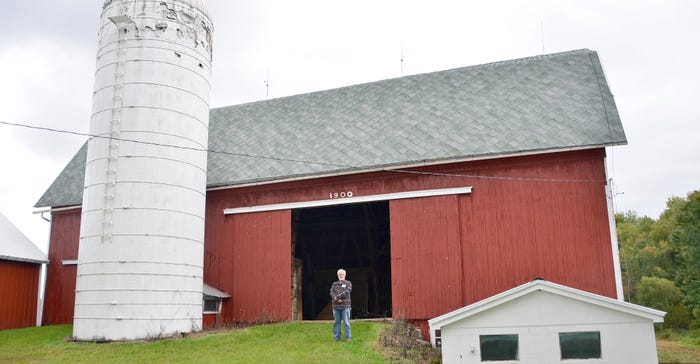June 7, 2021

There are people who love to tell you about their barn. And then there is John Mills, who really loves to tell you about his barn.
It isn’t that the barn has been in his family for generations. It isn’t unique in its construction, nor does it have a backstory of bootleggers who hid hootch in the silo. It wasn’t home to cows who produced the most butterfat. It did not ever stable stakes-winning racehorses.
But the ordinary red barn set into a hill near Howell, Mich., is loved and cared for, and that’s all that matters — and not only to John Mills, but also to a member of the Kenneth Filkins family who once owned the barn.
“I was at the barn one day,” John said, “and this car stopped at the road. A woman got out and had tears in her eyes when she saw the barn. Oh, the look on her face!” She had grown up in the farmhouse across the road and had fond memories of the barn.
John grins. “She said she never believed it would look this good again, and she was so happy at what she saw,” he says. “It is very gratifying to me.” The barn, she told him, was where plenty of work was done, of course, but it was also where news was exchanged and decisions were made.
John’s parents did not want him to live a farmer’s life, he explains. He went off to college, went to work, but still “dabbled” in farming. After retiring at 51, he focused on farming, growing his holdings to the acreage he farms today with the help of a grandson, Andrew.
“When I purchased this property with its original 40 acres and barn that is now 121 years old, the barn was in dire need of attention,” John says. “It was being pulled down by vines that were tearing at boards and holding moisture to the wood.” He points to where water had been seeping into the foundation.
“Fortunately, the barn had been reroofed before Mr. Filkins’ passing in 2016. Lose the roof, and sooner rather than later, you lose the barn and every bit of potential,” John cautions. “Old barns, while magnificent in size, architecture and construction, are frustrating because they have limited use on a modern farm without adaptation or changing weight-bearing.”
The barn’s roof is a patented shingle known as Art-Loc that resists wind damage.
Saving history
“I have put money into this barn,” John says, sliding open the doors at the banked portion of the barn that faces Preston Road. “And it needs more work. But I have saved it. The craftsmanship is like nothing we do today.”
The 40-foot-by-70-foot gambrel barn was built in 1900. Some dates painted on barns refer to when the land was settled, although a barn may well have been built the same year, and still others refer to when the most recent owner took possession if the farm has left the founding family.
As John provides a tour of his barn, he becomes more animated. “See the way these steps to the basement have a hollowed-out area right here at the doorway?” he says. “Mr. Filkins would pull his very heavy cans of milk up those stairs, and they wore out that top step.”
The well-worn steps to the long-ago milking parlor with its 20 stanchions are narrow and very steep. Mr. Filkins had to have been young and strong when he did his milking. The hefting of milk cans day after day gave him muscles of iron but, like his peers, eventually knees and shoulders that ached. He wore those out too, but without complaint, John says with respect.
Like many barns, the mow-level has a granary in one corner. This one contains six bins but, surprisingly, is not peppered with old license plates to keep rats and mice from using knotholes as a point of entry.
“You would not believe the amount of junk I hauled out of that granary when we bought the place,” John says. “Barns sure can collect a lot of junk, and it’s a shame that they do.”
His barn, like others remaining in rural settings, may be small by barn standards, but it makes an enormous deer blind. John’s grandson Brenden found the haymow provides a perfect elevated position from which to patiently await the deer that visit a sweetcorn patch behind the barn.
With grandson Andrew, John farms acreage around the barn and additional land in Howell, Cohactah and Osceola townships, and he is hoping Andrew will take interest in keeping the barn in good shape.
“He can make use of it,” he says. “It can easily store several things and could earn a little in rent.”
John isn’t quite sure what to do about weather damage to one of two unused silos, one in front and one behind the barn. Staves near the top have buckled. He has secured wire mesh over some of them. More work is needed.
“My parents, who pushed me away from the farm and off to college, did not realize what quality of life they had on the farm,” John says, gazing at his barn and fields. “Farmers can look back at the end of the day and say, ‘I got something of value done. It is good.’”
Old barns have value, too, whether because a person has a new purpose among the dozens and dozens of new uses being found, or because they simply love the barn and appreciate the life it once had or has. They love its stories.
John Mills and his old barn have plenty of stories.
Arnett is the author of “American Barns” and co-founder of Barn Believers Community Project Fund, held by the Battle Creek Community Foundation. Barn Believers makes grants to nonprofits for barn-related projects; visit barnbelievers.org. Arnett writes from Battle Creek and may be reached at [email protected].
About the Author(s)
You May Also Like




